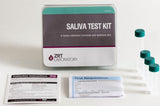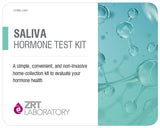Estradiol & Testosterone Saliva Test Kit
At-home saliva test for Estradiol (E2) and Testosterone (T). For men and women. Detects potential hormone imbalance linked to energy, mood, libido, weight, skin, and cycle changes.
What this test measures
- Estradiol (E2): Menstrual health, bone, skin, mood, vaginal comfort.
- Testosterone (T): Libido, muscle mass, energy, confidence, cognition.
- How and when to Collect your saliva samples: Saliva Testing Instructions
- Click to see >> Sample Saliva Test Result Report
Who it’s for
Use if you notice any of the following:
- Women: low libido, fatigue, cycle changes, hot flushes, vaginal dryness, mood swings, skin or hair changes, bone concerns.
- Men: low libido, erectile changes, fatigue, abdominal fat, low strength, mood changes, brain fog, sleep issues.
Key benefits
- Non-invasive: Simple saliva collection at home.
- Actionable: Clear graphs + numbers with specialist comments.
- Fast: Results 3–5 working days after lab receipt.
- All ages: Adults and children.
- All-inclusive: Lab fee included. No extra taxes.
- Flexible: Kit valid 12 months from purchase.
- Privacy: You ship samples to the lab with provided instructions.
How it works
- Order kit.
- Collect saliva following the instruction card.
- Post samples to the lab.
- Get your secure report with PhD Hormone Specialist notes and next-step recommendations.
What you get
- Saliva collection kit + step-by-step guide.
- Lab analysis of Estradiol and Testosterone.
- Visual report (graphics + values) and expert interpretation.
FAQ
What hormones are tested?
Estradiol (E2) and Testosterone (T).
Why saliva instead of blood?
Saliva reflects bioavailable (active) hormones. Collection is painless and timed precisely.
Do I need to fast?
No. Follow the timing instructions in the kit.
When should women test?
If cycling, collect as instructed (typically luteal guidance is provided). If not cycling, test any day.
I’m on HRT or birth control. Can I test?
Yes, but timing matters. Follow the kit notes or consult your clinician before sampling.
How long do results take?
3–5 working days after the lab receives your sample.
Will I get recommendations?
Yes. Your report includes PhD specialist comments and suggested next steps to discuss with your clinician.
Is this a diagnostic test?
It informs care. It does not diagnose disease. Review results with a healthcare professional.
Who pays shipping?
You ship the samples to the lab. Instructions provided.
How long is the kit valid?
12 months from purchase.
Optimize your hormone health. Measure Estradiol and Testosterone at home and get clear, expert-reviewed insights you can act on.
How to use:










